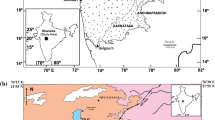Abstract
Relationship for the transformation of percentage values, plotted in a conventional regular tetrahedron, to 3-dimensional cartesian co-ordinates is derived to facilitate the calculation of statistical measures. Regression relationship is worked out using the recomputed values for six basalt compositions (data taken fromVemban, 1947) to numerically generalise the trend of crystallization.
Similar content being viewed by others
References
Chayes, F., 1965,Classification in a ternary diagram by means of discriminant functions. Am. Min.,50, p. 1618–1633.
Fuller, G., 1967,Analytical Geometry. Addison-Wesley Publ. Co., Reading, 3rd Ed., 243 pp.
Korzhinskii, D. S., 1957,Physicochemical basis of the analysis of minerals. Consultant Bureau, N. Y., 142 pp.
Krumbein, W. C. andGraybill, F. A., 1965,An introduction to statistical models in geology. McGraw-Hill Book Co., London, 475 pp.
Vemban, N. A., 1947,Differentiation trends in Deccan Traps. Proc. Ind. Acad. Sci.,25, Sec. A, No. 2, p. 76–118.
Author information
Authors and Affiliations
Rights and permissions
About this article
Cite this article
Rao, S.V.L.N., Lahiri, A. Numeric generalization of trends in rocks of basaltic composition. Bull Volcanol 35, 859–866 (1971). https://doi.org/10.1007/BF02596851
Issue Date:
DOI: https://doi.org/10.1007/BF02596851




